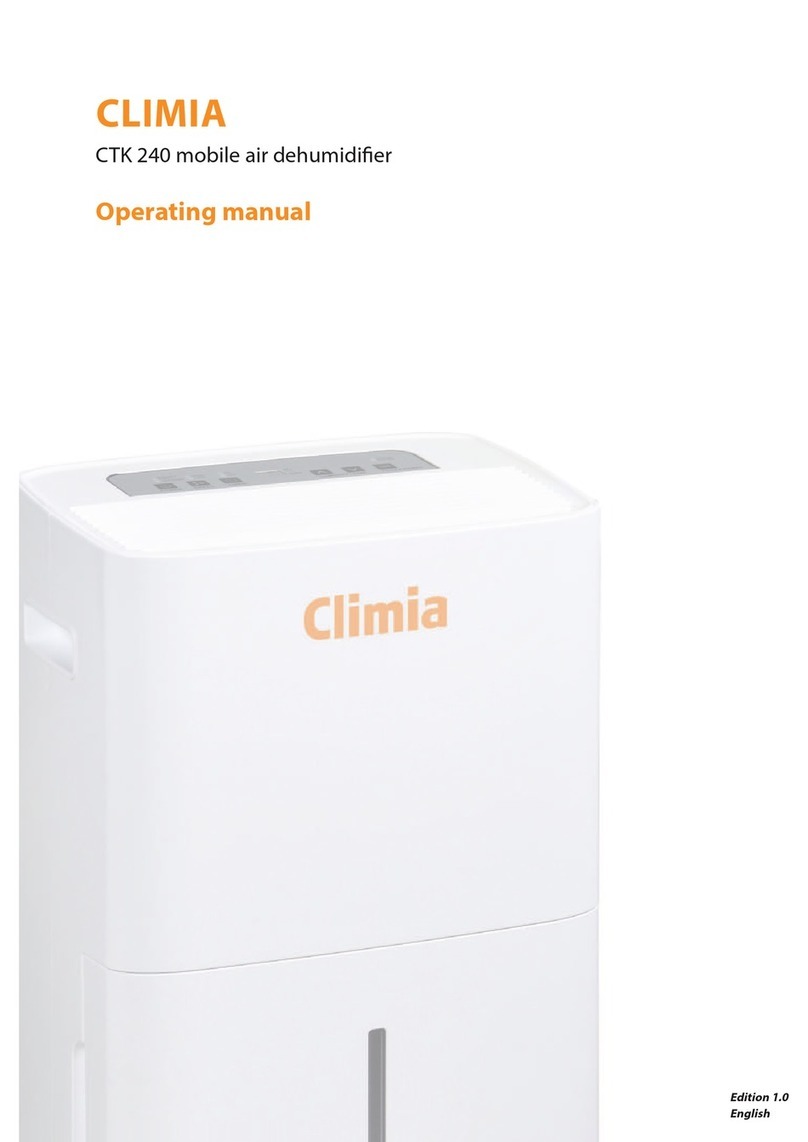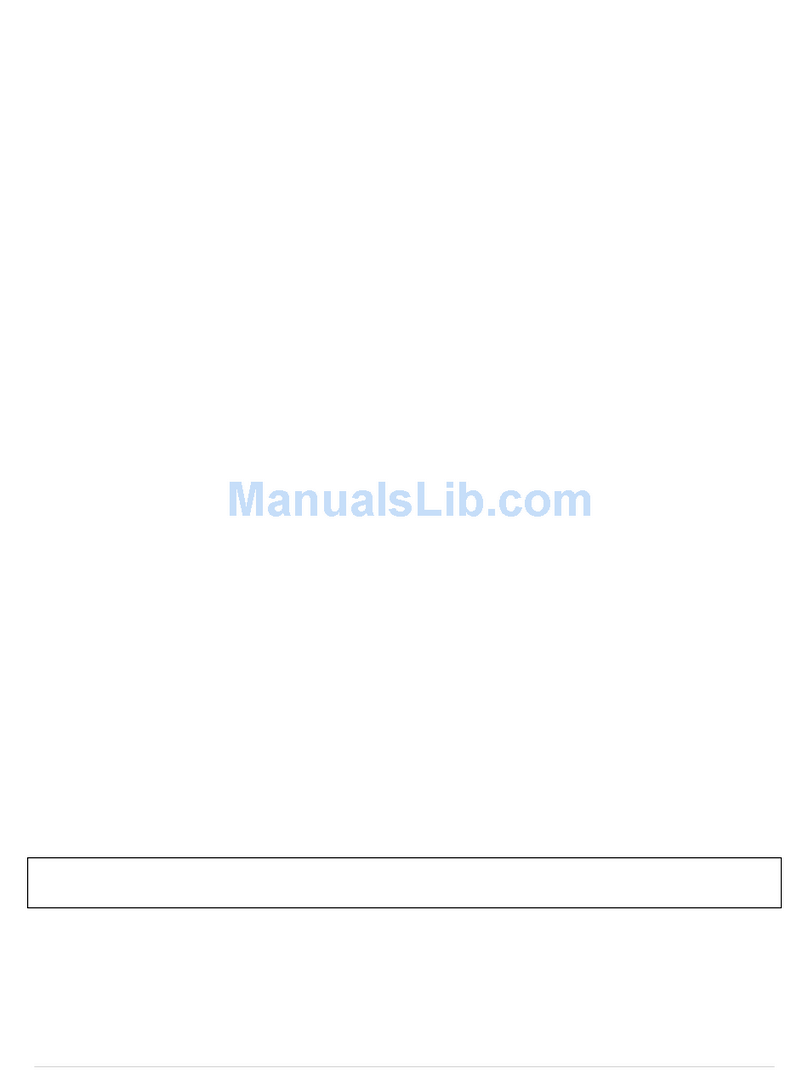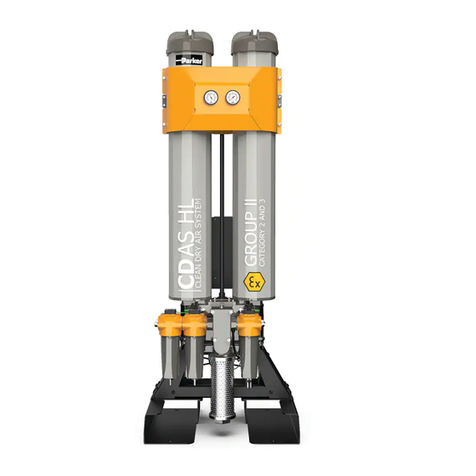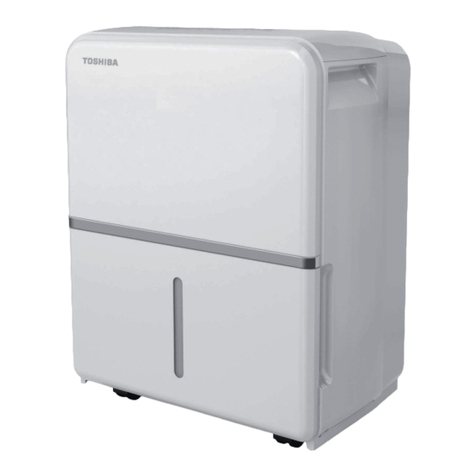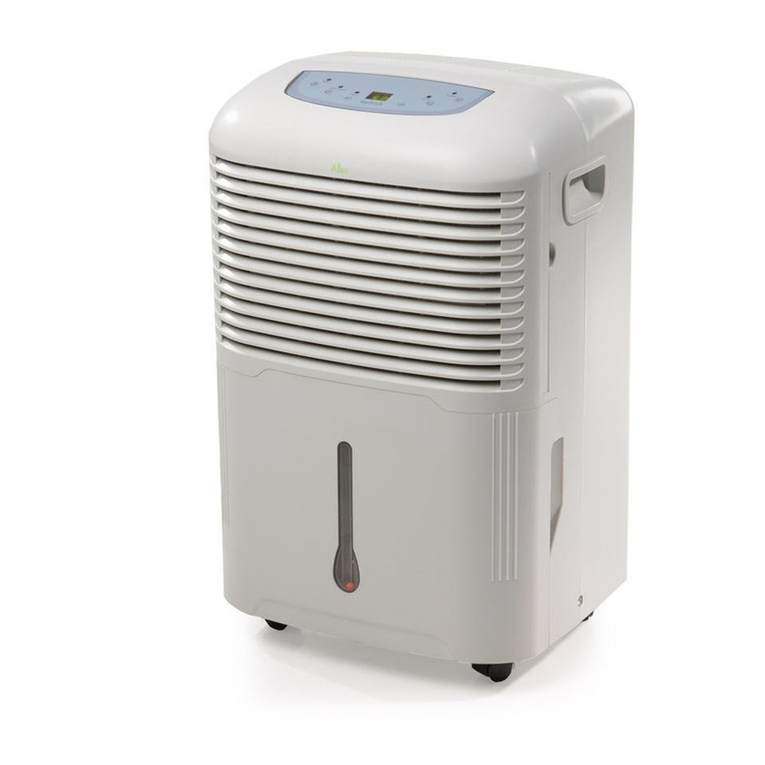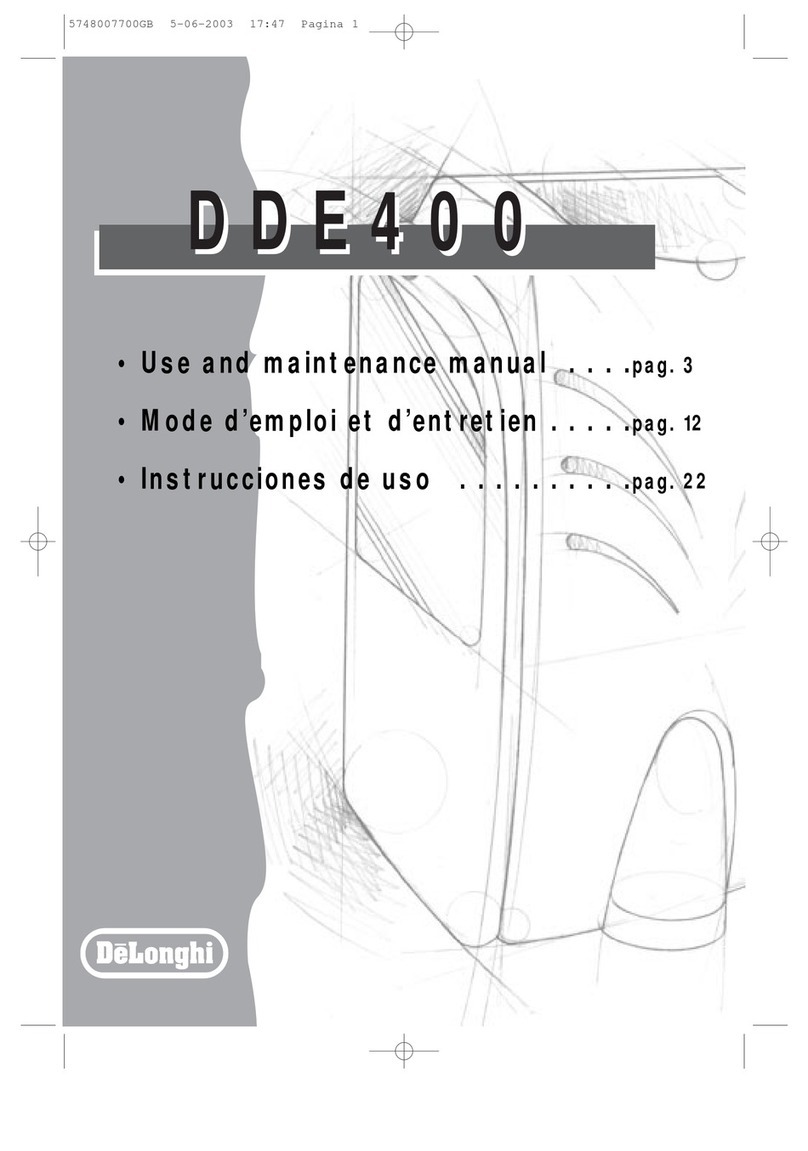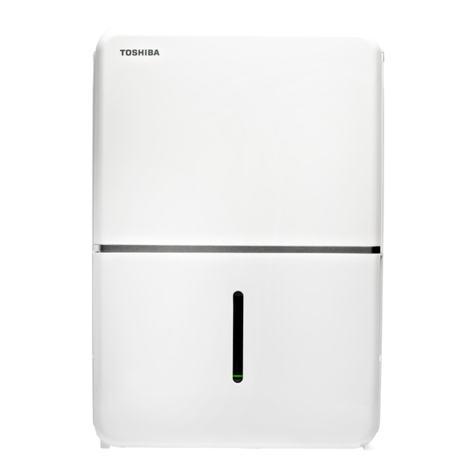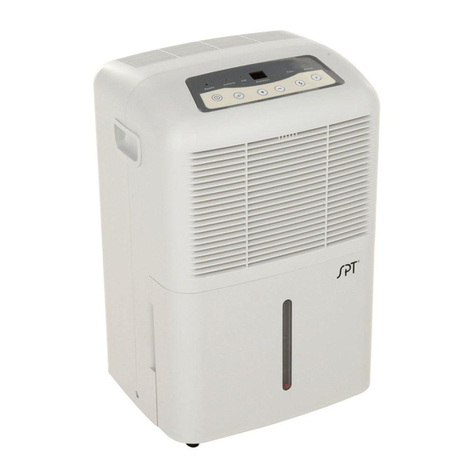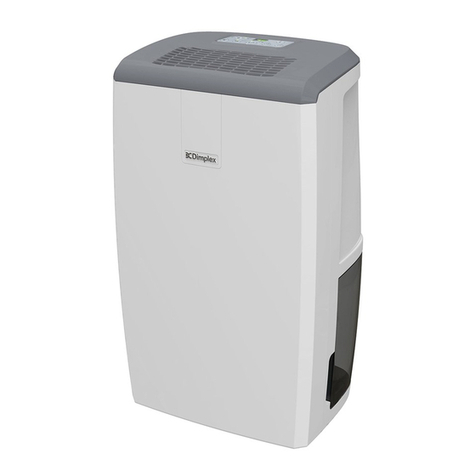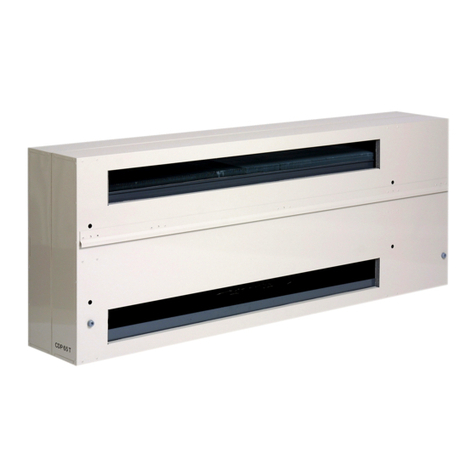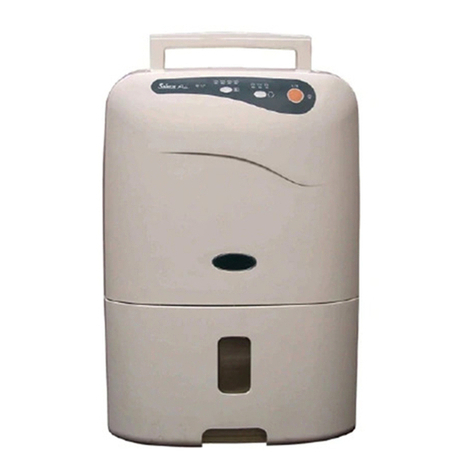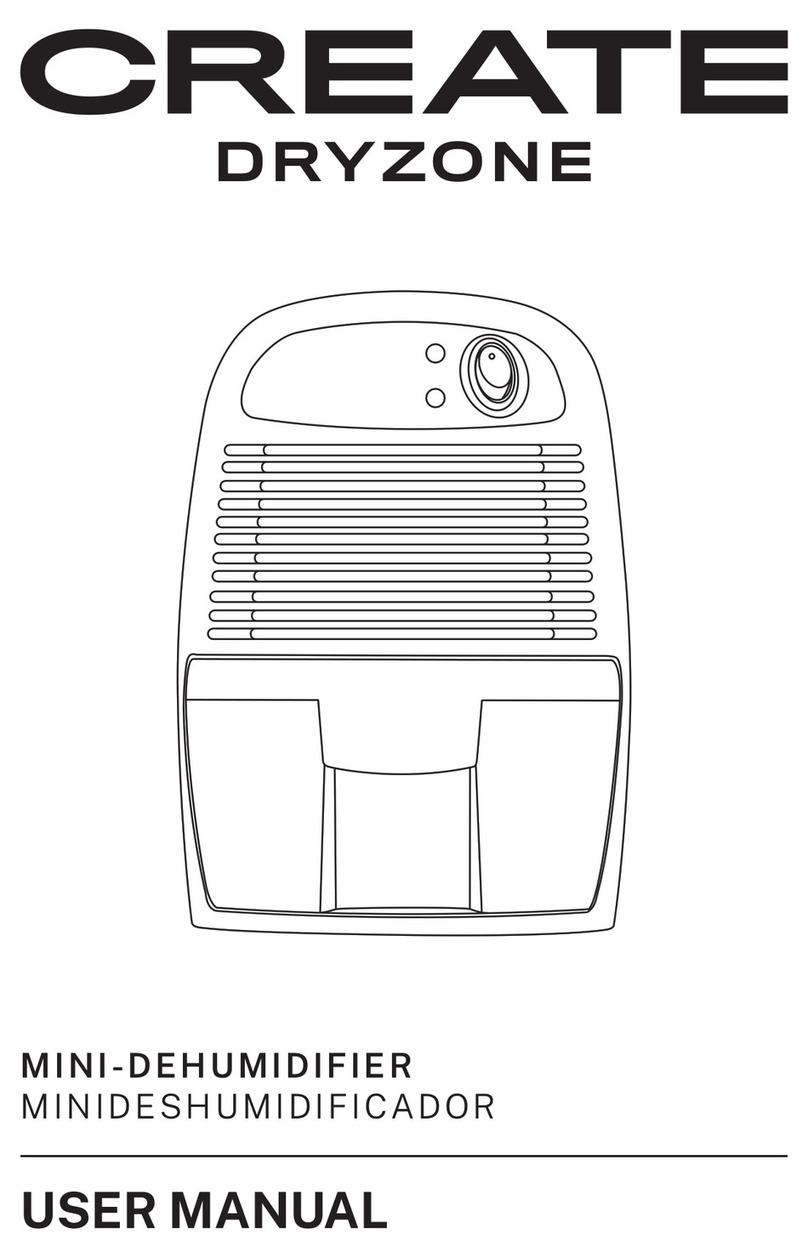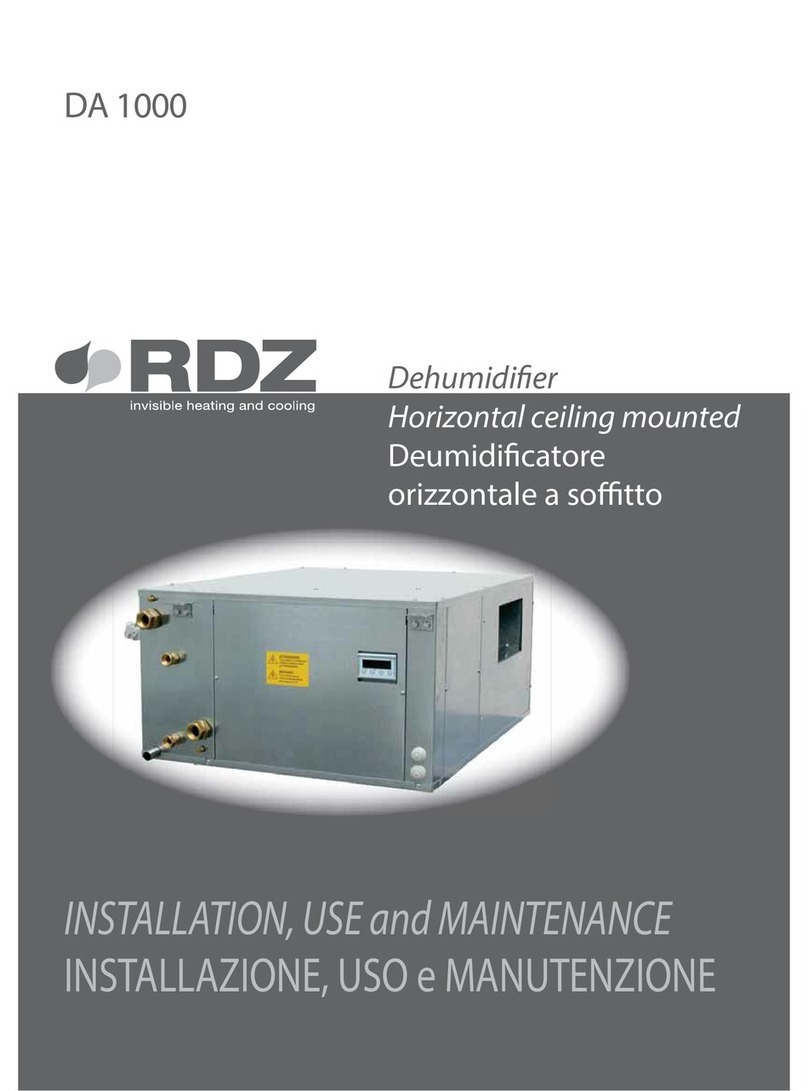CLIMIA CTK 190 User manual

CLIMIA
CTK 190 mobile air dehumidier
Operating manual
Edition 2.0
english
español
français
italiano
Instrucciones
de operación
Manuel
d‘utilisation
Manuale
d‘uso
nederlands
Gebruiks-
handleiding
deutsch
Bedienungs-
anleitung


3
Content
Carefully read this operating manual prior to commissioning/using the units!
This operating manual is a translation of the German original.
This manual is an integral part of the unit and must always be kept in the vicinity of the installation location
or on the unit itself.
Subject to modications. No liability accepted for errors or misprints!
1.0 Safety information 4-10
2.0 Environmental protection and recycling 11
3.0 Guarantee 11
4.0 Intended use 11
5.0 Transportation and packaging 11
6.0 Air dehumidication 12-14
7.0 Unit description 15
8.0 Set-up 16
9.0 Electrical wiring 17
10.0 Electrical wiring diagram 17
11.0 Commissioning 18-20
12.0 Shutdown 21
13.0 Unit transport 21
14.0 Care and maintenance 22-23
15.0 Troubleshooting and customer service 23-24
16.0 Unit illustration 26
17.0 Spare parts list 27
18.0 Maintenance log 28
19.0 Technical data 29
EC Declaration of Conformity 30

4
CLIMIA
1.0 Safety information
General safety notes
Carefully read the operating manual
before placing the unit in service
for the first time. It contains useful
tips and notes as well as hazard
warnings to prevent injury or
material damage. Failure to follow
the directions in this manual can
endanger persons, the environment
and the equipment itself and will
void any claims for liability.
•Keep this operating manual and
the refrigerant data sheet near to
the unit.
•This unit may only be installed
and operated as described in this
manual.
•Independent conversion and/or
modification of any kind is strictly
prohibited.
•National regulations in
connection with installation must
be observed.
•Children must not be left
unsupervised when close to the
unit.
•For safety reasons, people with
mental, physical or other health
limitations must not operate this
unit unattended.
•The unit is not permitted to be
operated with damaged cables.
The unit must be repaired by a
specialist immediately.
•The unit may only be operated
via a power supply with earthing.
•The use of extension cables is not
recommended.
•The air filter must be cleaned
at intervals of no more than 2
weeks.
•The unit is not permitted to be
operated in the vicinity of heat
sources.
•The unit must be transported
upright. Residue from the
condensate must be drained off
before transport. The unit must
be stood upright for 1 hour prior
to commissioning.
•Combustible substances and
pressure containers must be kept
at least 50 cm from the unit.
•The unit must not be stored and
operated in rooms with oil, gas or
sulphur.
•The unit must always be switched
off with the on/off switch.
•Do not place anything on the unit
in particular heavy or hot objects.
•Repairs may only be carried
out by authorised and certified
specialist personnel.
•This unit must be disposed of
professionally in accordance with
environmental protection.
•The safety notes in regards to the
room sizes and the flammability
of the refrigerant must not be
removed from the unit.
•The unit may only be operated in
well ventilated areas.
•The unit can be used by children
8 years and up and by persons
without physical, mental or
other health limitations if this
knowledge has been obtained
via the necessary safety notes.
•Children must never play with the
unit.
•Cleaning the unit must not be
carried out by children without
parental/guardian supervision.
•The unit is intended for indoor
use only (excluding laundry
rooms).
The following notes
must be observed in full:
•
The units must not be operated
at an ambient temperature
below 5 °C.
•
The units may not be set
up or operated in explosive
environments.
•
The units must not be installed
or operated in atmospheres
containing oil, sulphur, chlorine,
salt or dust.
•
Never insert foreign objects into
the units.
•
The units may not be exposed to
direct jets of water.
•
An unobstructed air inlet and air
outlet must be guaranteed at all
times.

5
CTK 190 mobile air dehumidier
•
The air-inlet grille must always
be kept free of dirt and loose
objects.
•
The units must not be covered
during operation.
•
The units must be installed
upright and in a stable position.
•
The units must not be
transported while they are
running.
•
All electrical cables on the
outside of the units must be
protected against damage (e.g.
by animals etc.)
.
•
Before each change of location,
the condensate containers must
be emptied
.
•Appropriate hazard prevention
measures must be taken to
prevent risks to people when
performing installation, repair,
maintenance or cleaning work on
the units.
•The units and components
should not be exposed to any
mechanical load, extreme levels
of humidity or direct exposure to
sunlight.
Warning of inflammable
substances
Additional safety notes when
handling refrigerant R290
•The refrigerant R290 fulfils the
requirements of the European
F-Gas regulation.
•The unit contains 0.122 kg of the
refrigerant R290.
•The maximum permitted amount
of refrigerant R290 is 0.3 kg.
•The unit must not be burned,
drilled or pierced.
•Only use cleaning agents which
have been approved by the
manufacturer for cleaning.
•The unit must never be operated
in rooms with naked flames (e.g.
gas heaters, open fireplaces, etc.).
•Refrigerant circuit components
must not be deformed.
•The contained refrigerant R290 is
colourless and odourless.
•The unit must not be stored or
operated in rooms which have a
room area of 6 m2or less.
•The accumulation of refrigerant
due to leakages can lead to a
fire and explosions in rooms
which are too small due to the
development of heat or ignition
sources.
•The units must be stored
carefully. Mechanical damage
must be avoided.
•Intervention in the refrigeration
circuit may only be done by
certified specialist personnel
taking into account the safety
notes of the manufacturer.
•Maintenance and repairs
may only be carried out by
authorised personnel who have
the corresponding knowledge in
regards to flammable refrigerant.
WARNING!
Do not use anything other than
the agent recommended by the
manufacturer to speed up a
possible defrosting process or to
clean the unit. The unit may only
be operated and stored in rooms
where there are no devices with
potential ignition sources. Donot
go below the minimum room
area of 5 m2. Note that leaking
refrigerant is colourless and
odourless. The unit must not be
burned or pierced!

6
CLIMIA
Safety instructions for the
operator
The operational safety of the units
and components is only assured
providing they are used as intended
and in a fully assembled state.
•This unit may only be installed
and operated as described in this
manual.
•Independent conversion and/or
modification of any kind is strictly
prohibited.
•Children must not be left
unsupervised when close to the
unit.
•For safety reasons, people with
mental, physical or other health
limitations must not operate this
unit unattended.
•The unit is not permitted to be
operated with damaged cables.
The unit must be repaired by a
specialist immediately.
•The unit may only be operated
via a power supply with earthing.
•The use of extension cables is not
recommended.
•The air filter must be cleaned
at intervals of no more than 2
weeks.
•The unit is not permitted to be
operated in the vicinity of heat
sources.
•The unit must be transported
upright. Residue from the
condensate must be drained off
before transport. The unit must
be stood upright for 1 hour prior
to commissioning.
•Operating the units in rooms with
potential ignition sources (naked
flames, gas or electrical heaters,
fireplaces) is prohibited.
•The unit may only be installed,
operated and stored in rooms
larger than 6 m2.
•Protective covers (grilles) over
moving parts must not be
removed from units that are in
operation.
•Do not operate units or
components with obvious
defects or signs of damage.
•Contact with equipment parts or
components can lead to burns or
injury.
•The units and components
must not be exposed to any
mechanical load, extreme
levels of humidity or extreme
temperatures.
•Never drill through the housing
cover or have the unit come into
contact with fire.
•Rooms in which refrigerant may
escape must be adequately
aerated and ventilated.
Otherwise there is danger of
suffocation.
•All housing parts and unit
openings, e.g. air inlets and
outlets, must be free from foreign
objects, liquids and gases.
•Do not leave the units running
for an extended period
unsupervised.
Improper use can cause serious
damage to the unit.
Read this manual carefully before
commissioning!

7
CTK 190 mobile air dehumidier
Never cover the air inlets and
outlets.
Do not allow children to play with
the unit
Do not stand or sit on the unit.
Unplug the power plug before
cleaning the unit.
Do not disassemble housing parts
(consult a specialist company).
Unplug the power plug when not in
use for a long period.
Ensure the voltage is correct
(220-240 V AC, 50 Hz).
Do not operate the unit with
defective cables or sockets.
The unit and in particular the
control panel must not come into
contact with water.

8
CLIMIA
Safety instructions for certied
specialist personnel
•
Check the work area
Before starting work on units
with combustible refrigerants,
ensure that any potential
ignition sources are removed
and the risk of igniting the
refrigerants is eliminated. The
aforementioned safety notes
for repairing the units must
be observed at all times. Work
may only be carried out by
authorised specialist personnel
with knowledge of handling
combustible refrigerants!
•
Prepare the work area
Any persons present must
be informed about the repair
process accordingly and
persons not involved must
vacate the work area. Working
in rooms with limited space
is prohibited. Ensure that
sucient space is available at
the workplace. Ensure that the
ambient conditions are suitable
for working with combustible
refrigerants.
•
Identify refrigerant leaks, check
the atmosphere
Refrigerant may unexpectedly
escape when working on the
refrigerant circuit. Ensure that
the atmosphere in the workplace
is not combustible at all times
by using suitable refrigerant
detectors. Be sure to ensure
that the refrigerant detector
used is suitable, approved
and calibrated for use with
refrigerant R290.
•
Provide re extinguishers
Provide appropriate re
extinguishers before starting
work. For this purpose, dry
powder or CO2re extinguishers
are suitable.
•
Remove any potential ignition
sources
Leaking refrigerant in
combination with corresponding
ignition sources can lead to an
explosion. All ignition sources
must therefore be kept away
from the work area at all times!
This also includes the smoking
of cigarettes. Inform all persons
present that this includes the
axing of safety notes and the
closing o of the work area.
•
Sucient ventilation
Before starting work, ensure
that the work area is outdoors
or has sucient ventilation. A
continuous ventilation stream
is required while working.
The safety of the persons
working must be guaranteed
by the exhaust air equipment:
potentially leaking refrigerant
must be lead away safely and
drained into the atmosphere in
an optimum manner.
•
Checking the refrigerant circuit
If electronic components need
to be replaced, ensure that
the spare parts have the same
function and identical technical
specications. The maintenance
and replacement regulations of
the manufacturer must always
be observed and complied with.
Please contact the support of the
manufacturer with any problems
or queries.
The following safety checks
must be carried out when using
combustible refrigerants:
- The ll level adjusts to the size
of the rooms in which the unit is
located.
- The exhaust air equipment and
its outlets function properly and
are not blocked or obstructed.
•
Checking the electronic
components
A component and safety check
must be carried out before
repairing and maintaining
electronic components. If
safety cannot be ensured due
to a defect on a component,
installation must not take place
until safety can be guaranteed
again. If the defect on the spare
part cannot be remedied and
downtime of the unit is no
longer acceptable, an adequate
temporary solution must be
arranged. The owner/operator
of the unit must be informed
about this. The detailed safety
check must include the following
aspects:
- Capacitors are discharged. A
safe discharge process must
be employed to prevent ying
sparks.
- There must be no electronic
components active or
uninsulated wires while lling,
repairing or cleaning.
- There must be no earthing of
the system.

9
CTK 190 mobile air dehumidier
•
Repairs to closed components
Before repairing closed
components/housing parts, the
unit must be free from voltage.
If carrying out the repairs free
from voltage cannot be avoided,
the critical points of potential
refrigerant leakages must be
checked using a leak detector.
The following notes must be
observed when working on
electronic components if the
housing is changed in such a
way that its safety is inuenced.
This also relates to cases where
the lines are damaged, there
is excessive or incorrect pin
assignment, connections are
not assigned in the original
way or similar deviations to
the expected condition are
determined.
•
Repairing intrinsically safe
components
Do not introduce permanent
inductive or capacitive loads
into the existing circuits without
ensuring that the maximum
permitted voltages and
amperages of the assemblies
and lines are not exceeded.
Intrinsically safe components are
individual components that can
be operated in the presence of
ammable substances. The test
equipment must be adjusted
according to the situation-
dependent conditions. Only use
components which are ocially
approved by the manufacturer
as spare parts. Unapproved
components can cause a re
in the event of a leakage in the
refrigerant circuit.
•
Wiring
Lines must be checked for the
following damage:
- Damage to the insulation -
Corrosion at the contact points
- Excessive pressure on the lines
- Damage due to vibrations
- Damage due to sharp edges
- Damage due to other
inuences not mentioned here
Also consider the ageing of
the material and continuous
vibration loads due to
compressors or fans when
checking.
•
Identify combustible refrigerant
Do not use any potential
ignition source when searching
for refrigerant leaks under any
circumstance. The use of a leak
detection lamp or other similar
units with a naked ame is not
permitted.
1. Ensure that the components
are installed correctly.
2. Ensure that sealing materials
are not changed in such a way
that combustible gases or
objects could penetrate into the
interior of the components.
3. Spare parts must correspond
to the manufacturer’s
specications.
•
Leak detection methods
The following leak detection
methods are permitted for
systems with combustible
refrigerants. Electronic
equipment must be used
for detecting leaks. These
must be selected with the
sensitivity matched to the
situation and recalibrated if
necessary (calibration must
take place in a refrigerant-free
environment). The leak detection
device must be adjusted to
the lowest ammability limit
(LFL) of the refrigerant. Liquid
leakage instruments are
permitted for most refrigerants.
Chlorinated substances are
the exception here as the
chlorine in combination with
the refrigerants can cause
corrosion on the copper cables.
If a leak is detected, all potential
open ignition sources must be
removed immediately. If a leak
has been detected in the system
which requires reworking of the
piping in the form of soldering,
the system must be completely
free of refrigerant or, if possible,
the aected part disconnected
from the system using stopcocks.
The aected system parts must
be ushed with oxygen-free
nitrogen run before and during
the repair work.
•
Emptying and evacuating the
system
If the refrigerant circuit must
be opened for repairs or other
reasons, this must be carried out
in a safe and professional way. In
any event, proceed with extreme
caution since ignition may occur
at any time!
NOTE!
The use of silicones can inuence
the eectiveness of leak
detection devices!
Intrinsically safe components
must not be insulated before
starting work!

10
CLIMIA
Stick to the following procedure:
1. Drain the refrigerant
2. Flush the system with insert
gas
3. Evacuate
4. Repeat steps 2 to 3 if required
5. Opening the system by cutting
or soldering
The system must be ushed with
oxygen-free nitrogen in order to
guarantee safety. The ushing
process must be repeated
multiple times if necessary.
Do not use compressed air or
oxygen for the ushing process!
After evacuating, ushing
takes place by lling with dried
nitrogen until the operating
pressure is reached and then
the system must be evacuated
again. This ushing process must
often be repeated until there
is no more refrigerant in the
system. After the last ushing,
the system must be brought to
the ambient pressure in order
to start work. The ushing
process is indispensable when
soldering work is required on the
piping. Ensure that the vacuum
pump outlet is not near an
ignition source and continuous
ventilation is guaranteed.
•
Filling process
The following requirements for
the general specications must
also be fullled during the lling
process:
- Ensure that no contamination
occurs from other refrigerants
(residues in the lling system).
- Keep the lines as short as
possible to minimise the
likelihood of residues forming.
- Filling bottles and cylinders
must be stood upright.
- Ensure that the system is
earthed before lling.
- Label the system with the
refrigerant type designation
•
Leak detection methods
The following leak detection
methods are permitted for
systems with combustible
refrigerants. Electronic
equipment must be used for
detecting leaks. These must be
selected with the sensitivity
matched to the situation
and recalibrated if necessary
(calibration must take place in
a refrigerant-free environment).
The leak detection device
must be adjusted to the
lowest ammability limit
(LFL) of the refrigerant. Liquid
leakage instruments are
permitted for most refrigerants.
Chlorinated substances are
the exception here as the
chlorine in combination with
the refrigerants can cause
corrosion on the copper
cables. If a leak is detected,
all potential open ignition
sources must be removed
immediately. If a leak has
been detected in the system
which requires reworking
of the piping in the form of
soldering, the system must be
completely free of refrigerant
or, if possible, the aected part
disconnected from the system
using stopcocks. The aected
system parts must be ushed
with oxygen-free nitrogen run
before and during the repair
work.
•
Emptying and evacuating the
system
If the refrigerant circuit must
be opened for repairs or other
reasons, this must be carried
out in a safe and professional
way. In any event, proceed with
extreme caution since ignition
may occur at any time!
after lling
- Never exceed the maximum
ll level. The system must be
checked for leaks (pressure
test!) before lling. The system
must be checked for leaks once
more after lling and before
commissioning. Check for leaks
again when leaving the work
space.
•
Labelling when shutting down
If a unit must be taken out of
operation and the refrigerant
must be disposed of, the unit
must be labelled with the date
and a signature. Ensure that the
note remains attached to the
combustible refrigerant.
•
Transportation of units
which contain combustible
refrigerants
National provisions must be
observed.
•
Storing of units which contain
combustible refrigerant
National provisions must be
observed.
•
Transportation without the
original packaging
If the units are transported
without the original packaging,
they must be packed in such a
way that mechanical damage
is prevented. The units must be
transported upright.

11
CTK 190 mobile air dehumidier
The units are shipped in sturdy
transport packaging. Check the
unit immediately after delivery and
make a note of any damage (please
take photos of the damage) or
missing parts on the delivery note.
Inform the forwarding agent and
contractual partner.
Please keep the packaging safely for
any returns.
Claims under guarantee made at a
later date will not be accepted.
5.0 Transportation and
packaging
4.0 Intended use
The units are designed exclusively
for drying and dehumidication
purposes on the basis of their
structural design and equipment.
The units must not be used for any
other purpose.
The units are only permitted to
be operated by people with the
relevant training and understanding
of how to handle them.
Any different or additional use shall
be classed as non-intended use. The
manufacturer/supplier assumes no
liability for damages arising from
non-intended use. The user bears the
sole risk in such cases.
Intended use also includes working
in accordance with the operating
and installation instructions and
complying with the maintenance
requirements.
3.0 Guarantee
As a prerequisite for any guarantee
claims to be considered, it is
essential that the ordering party
or its representative complete and
return the "certificate of warranty"
to Climia Intakt GmbH at the time
when the units are purchased and
commissioned.
The guarantee conditions are
listed in the "General terms
and conditions of business and
supply". Furthermore, only the
parties to a contract can conclude
special agreements beyond these
conditions. In this case, contact
your contractual partner in the first
instance.
Disposal of packaging
All products are packed for
transport in environmentally
friendly materials. Make a valuable
contribution to reducing waste
and sustaining raw materials. Only
dispose of packaging at approved
collection points.
Disposing of the units and their
components
Only recyclable materials are used
in the manufacture of the units and
components.
Help protect the environment
by ensuring that the units or
components (for example batteries)
are not disposed of in household
waste, but only in accordance
with local regulations and in an
environmentally safe manner,
e.g.using authorised disposal and
recycling specialists or council
collection points.
2.0 Environmental
protection and recycling

12
CLIMIA
It is evident that the corrosion rate
below 50% relative humidity (RH) is
low, and below 40% is negligible.
The corrosion rate increases
signicantly above 60% RH. This
threshold for damage as the
result of humidity also applies to
other materials, such as powdery
substances, packaging, wood and
electronic units.
Buildings may be dried in a variety
of ways:
1. By heating and air exchange:
The air in the room is heated in
order for moisture to be removed
and then this air is fed outside.
All of the energy that is involved
is lost together with the moist air
that is released.
2. By air dehumidication:
The moist air that is present
within an enclosed space is
continuously dehumidied
according to the condensation
principle.
With regard to energy consumption,
air dehumidication has one
distinct advantage:
Energy expenditure is limited
exclusively to the air volumes
present. The mechanical heat that
is released by the dehumidication
process is fed back into the room.
Under normal use, the
air dehumidier
uses
approximately 25% of the
energy that is required for
the
"heating and ventilating"
principle.
Relative air humidity
Our ambient air is a gaseous
mixture which always contains a
certain volume of water in the form
of water vapour. This volume of
water is specied in g per kg of dry
air (absolute moisture content).
1m3of air weighs approx. 1.2 kg at
20°C
Depending on the temperature,
each kg of air is only capable of
absorbing a certain volume of
water vapour. Once this capacity
has been reached, the air is referred
to as“saturated” and has a relative
humidity (RH) of 100%.
Relative humidity is understood to
mean the ratio between the current
quantity of water vapour in the air
and the maximum possible quantity
of water vapour at the same
temperature.
The ability of the air to absorb water
vapour increases as the temperature
rises. I.e. the maximum possible
(absolute) water content becomes
greater as the temperature rises.
The correlations occurring when
air is dehumidied are based on
physical laws.
These are depicted here in graphical
form in order to provide you with a
brief overview of the principles of
air dehumidication.
Using
Climia air dehumidiers
•
Even if windows and doors
are well insulated, water and
moisture are still capable of
penetrating thick concrete walls.
•
The water required for setting
in the production of concrete,
mortar and plaster etc. may only
be diused after 1-2 months.
•
Even moisture trapped in the
masonry after high-water or a
ood is released very slowly.
•
The same is also true of moisture
contained in stored materials for
example.
The moisture (water vapour)
released from parts of a building
or materials is absorbed by the
surrounding air. As a result, the
moisture content increases, which
ultimately gives rise to corrosion,
mould, rot, peeling of paint and
other unwanted damage.
By way of example, the diagram
shows the corrosion rate of metal in
dierent levels of humidity.
6.0 Air dehumidication
Corrosion rate
Relative humidity %

13
CTK 190 mobile air dehumidier
Building materials and structures
are capable of absorbing
considerable volumes of water, such
as brick 90-190 l/m³, heavy concrete
140-190 l/m³ and limestone 180-270
l/m³.
The drying of moist materials such
as masonry is eected as follows:
•
The moisture moves
from the inside of
the material to its
surface
•
Evaporation occurs on the
surface = Transfer of water
vapour to the ambient air
•
The air containing water vapour
is constantly circulated through
the air dehumidier. The air
is dehumidied and, slightly
heated, leaves the unit in order
to re-absorb water vapour
•
In this way, the moisture
contained in the material is
reduced gradually.
The material is dried!
The accumulated condensate is
collected in the unit and drained o
from there.
Drying materials
Verdampfer Kondensator
°C
30
25
20
15
% r.F.
100
90
80
70
60
50
40
30
20
10
+
+
-
Lufttemperatur
Luftfeuchte
Verlauf
Luftrichtung
As it ows through or over the evaporator, the air stream is cooled to dew
point. The water vapour condenses, and is collected in a condensate trap
from where it is drained o.
Temp. Water vapour content in g/m3at humidity of
°C 40% 60% 80% 100%
-5 1.3 1.9 2.6 3.3
+10 3.8 5.6 7.5 9.4
+15 5.1 7.7 10.2 12.8
+20 6.9 10.4 13.8 17.3
+25 9.2 13.8 18.4 23.0
+30 12.9 18.2 24.3 30.3
Water vapour condensation
Because the capacity for the
maximum possible volume of
water vapour increases as the air is
heated, the volume of water vapour
contained remains constant and so
relative humidity falls.
In contrast, because the capacity for
the maximum possible volume of
water vapour decreases as the air is
cooled, the volume of water vapour
contained remains constant and so
relative humidity increases.
If the temperature continues to
fall, the capacity for the maximum
possible volume of water vapour
is reduced so much so that it is
ultimately equal to the volume of
water vapour contained in the air.
This temperature is referred to as
the dew point. If the air is cooled
to below dew point, the volume of
water vapour in the air will become
greater than the maximum possible
volume of water vapour.
At this point, the water vapour
begins to precipitate.
This condenses to water and
moisture is removed from the air.
Examples of condensation include
steamed-up window panes in
winter, or the moisture on the
outside of a cold drinks bottle.
As the relative humidity of the air
increases, so too does the dew
point, making it easier for the
temperature to fall below it.
Evaporator Capacitor
Air temperature
Air humidity
Progression
Air direction

14
CLIMIA
Condensation heat
The energy transferred to the air
from the condenser consists of:
1. The amount of heat derived
beforehand in the evaporator.
2. The electrical drive energy.
3. The condensation heat released
by liquefying the water vapour.
Energy must be supplied when
liquid is converted into a gas.
This energy is designated as
evaporation heat. It does not cause
any increase in temperature, but is
required to convert a liquid into a
gas. Conversely, energy is released
when gas is liquefied, this is
designated as condensation heat.
The amount of energy from
evaporation heat and condensation
heat is the same.
For water, this is:
2250 kJ/kg (4.18 kJ = 1kcal)
From this it is evident that the
condensation of water vapour
causes a large quantity of energy
to be released.
If the moisture that is to be
condensed is not introduced by
evaporation in the room itself,
but from outside, e.g. through
ventilation, the condensation heat
released contributes to the heating
of the room.
With drying operations, a heat
cycle is created, whereby heat
is consumed for evaporation
and released for condensation.
When dehumidifying fed air,
a larger contribution of heat is
created, which manifests itself as a
temperature increase.
Generally speaking, the time
required for the drying process is
not only dependent on the output
of the unit, but is determined to
a greater extent by the speed at
which the material or building
section loses its moisture.

15
CTK 190 mobile air dehumidier
7.0 Unit description
Operating sequence
The units are switched on and off
by the power key.
The fan extracts the moist room air
through the intake grill with filter,
evaporator and the condenser
behind.
Heat is removed from the room air
on the cold evaporator. The air is
then cooled to below dew point.
The water vapour contained in
the room air is then deposited
as condensate or rime on the
evaporator fins.
On the condenser (heat
exchanger), the cold and
dehumidified air is warmed up
again and discharged back into
the room via the outlet grill
with a temperature increase of
around 5 - 10 °C above the room
temperature.
The processed, dry air then re-
mixes with the room air.
Continuous circulation of the room
air through the unit gradually
reduces the relative humidity
(% RH) in the room to the desired
humidity level.
Depending on the room air
temperature and the relative
humidity, condensed water will
drip into the condensate trap
and then through the integrated
discharge nozzle into the
condensate container below either
continuously or only during the
defrosting phases.
A float is installed inside the
condensate container. In the event
that the container is full, the float
will activate a microswitch which
will switch off dehumidification
mode.
The units switch off and the
“container full” indicator light
on the control panel illuminates.
This extinguishes again when
the empty condensate container
is re-inserted.
The units then restart after
aswitch-on delay of around 3
minutes.
In unattended continuous
operation with an external
condensate connection, the
condensate that occurs is
drained continuously via a hose
connection.
The units have been designed for
universal and straightforward air
dehumidification.
Their compact dimensions allow
the unit to be transported and set
up with ease.
The units operate in accordance
with the condensation principle
and are equipped with a
hermetically sealed refrigerant
system, heat gas defrosting, low-
noise and low-maintenance fan
and connection cable with plug.
The fully automatic control, the
variable hygrostat, the condensate
container with integrated overflow
protection and the connection
nozzle for condensate drainage
guarantee fault-free continuous
operation.
The units conform to the
fundamental health and safety
requirements of the appropriate
EU regulations.
The units are dependable and offer
ease of operation.
The units are used in all locations,
where dry air is a must and where
economic consequential damage
(such as that caused by mould)
must be prevented.
The units may be used for the
drying and dehumidification of
areas such as:
•
Living rooms, bedrooms,
shower rooms or cellar rooms
•
Weekend homes and
caravans
•
Warehouses, archives,
laboratories
•
Bathrooms, wash rooms and
changing rooms etc.
•
Basements, storage rooms
Recirculating fan
Condensate
container
Capacitor
Evaporator
Condensate trap
Compressor
Moist room air
Dehumidied
room air
Fig. 1 Schematic depiction of the workings of the air dehumidier

16
CLIMIA
8.0 Set-up
For the best economic and safe use
of the units, the following notes
must be followed in full:
•
The units must be set up in an
upright and level position, to
ensure that the condensate can
drain freely
•
To ensure optimum air
circulation, the units should be
set up in the centre of the room,
where possible
•
Ensure that the room air can
be sucked in and discharged
without hindrances
•
Observe a minimum clearance of
50 cm from walls at all times
•
Units must never be set up in the
immediate vicinity of heaters or
other sources of heat
•
Air circulation is improved if the
unit is set up approx. 1 m above
the ground
•
The room being dried or
dehumidied must be closed to
the surrounding atmosphere
•
Avoid having opened windows
and doors etc., and avoid
frequent entry to or exit from the
room as much as possible
•
The units may not be used in
environments containing a
great deal of dust or chlorine,
or in places with atmospheres
containing ammonia
•
The output of the unit is
entirely dependent on the
conditions inside the room, room
temperature, relative humidity
and observance of the set-up
instructions
Min. 0.5 m
distance to wall
Maintain adequate clearance from
heaters or other sources of heat.
Keep windows and doors closed!
Fig. 2 Schematic depiction of how to set up the air dehumidier

17
CTK 190 mobile air dehumidier
•
The units are operated with
230V / 50Hz alternating
current
•
The electrical connection is
established using a built-in
mains cable with earthed safety
plug
•
Extensions to the connection
cable may only be carried out
by authorised electricians,
subject to the length of
the cable, connected load
of the unit and taking into
consideration how the unit is
used at its location
9. 0 Electrical wiring
NOTE
The electrical connection to the
units must be made at feed-
points with residual current
devices in accordance with
VDE0100, Section 704.
When installing the units in
extremely damp environments
such as laundry rooms, showers
etc., the unit must secured with a
residual current device provided
by the customer in accordance
with the regulations.
CAUTION!
All cable extensions must only be
used in fully unreeled or reeled
o condition.
10.0 Electrical wiring diagram
230V~50Hz
L N
BRAUN
BLAU
PE
GRÜN/GELB
BLAU
ROT
Kompressor
Kondensator
Kondensator
BLAU
WEISS OLP
WEISS
BLACK
Ventilator
CN1
CN2
CN3 CN4
T. Sensor
Bedienplatine
F. Sensor
FUSE
P3
P4
P9
T1AL 250V
BLAU
P5
P12
P1
BLAU
ROT
BLAU
2-Wege
Magnet-
ventil
Mikro-
schalter
Capacitor
Capacitor
Compressor
FUSE
H. probe
Operating board
BLUE
T. probe Microswitch
Fan
2-way
solenoid
valve
BLUE
BLUE
RED
BLUE
WHITE
WHITE
BLACK
BLUE
BLUE
BROWN
GREEN/YELLOW
OLP
RED
Fuse

18
CLIMIA
2. Open the air flap on the top of
the unit.
3. Press the power key.
4. Use the set key to select the
desired humidity level in the
installation room.
11.0 Commissioning
Before commissioning the unit or if
local requirements dictate, the air-
inlet grill and air-outlet grill must
be checked for contamination.
Important notes prior to
commissioning
•
All extensions to the electrical
connection must be of a
sufficient cable size and must
only be used fully rolled out or
unrolled
•
Never use the power supply
connection cable as a pull cord
•
After being switched on,
the units operate fully-
automatically until switched off
by the hygrostat or float when
the condensate container is full
•
The condensate container must
be inserted properly
The unit cannot be operated if
the condensate container is not
inserted properly!
•
In order to prevent damage to
the condenser, the units are
equipped with a mechanism
that prevents the compressor
being immediately switched
back on after it is switched off
The units do not switch back
on until a waiting time of
around
3 minutes has elapsed!
•
If the units work in continuous
operation with an external
condensate drainage
connection, refer to the
relevant section
Control panel
MAX. AUTO
rF
SET
21
4
356
Power key
The POWER key switches the unit on and off.
SET key
Use the SET key to select the desired humidity in the installation
room.
“MAX.” status light
This light indicates that the unit is in continuous operation.
“AUTO.” status light
These lights indicate which humidity level has been set.
“Container full” indicator light
This light indicates that the condensate container is full and must be
emptied
“Defrost mode” indicator light
This light indicates that the automatic defrost system that is
integrated in the unit has switched on the defrost cycle
1
2
3
4
5
6
Commissioning the units
1. Connect the unit's electrical
connection to a properly
installed mains socket.
NOTE
A contaminated grille or lter
must be cleaned or replaced
immediately.
NOTE
In room temperatures below
10°C
and relative humidity
below
40%
, economical use
of the unit can no longer be
guaranteed.
NOTE
Note that the compressor does
not switch on until a waiting
time of 3 minutes has elapsed.
Restart protection!
CAUTION!
The units are only permitted
to be operated with the air
flap open in order to prevent
overheating.
NOTE
The devices can be switched
ON and OFF via an external
time (accessory) if required.

19
CTK 190 mobile air dehumidier
Adjusting the discharge
direction
The dehumidified room air is
discharged on the top of the unit.
The pivotable air flap [S] is used to
adjust the discharge direction.
Press the air flap’s rear surface [D]
to open it.
The front folds upwards. The air
direction can be adjusted infinitely.
The following notes must also be
observed in full:
•
If possible, open the air flap
completely to direct the air flow
upwards
•
Ensure that the air can
discharge without hindrances
This is the only way to
guarantee optimum unit
operation!
•
Ensure that sensitive objects
such as house plants are not
placed directly in the air flow
emerging from the unit
DS
Automatic defrost system
The moisture contained in the
room air condenses when cooling
and coats the evaporator fins
with rime or ice depending on the
air temperature and the relative
humidity (% RH).
The automatic defrost system that
is integrated in the unit switches
the defrost cycle on if required.
The rime or ice that has
accumulated on the exchanger
surfaces is defrosted using heat gas
as required.
This defrosting method is
particularly fast and effective, and
guarantees high dehumidification
performance.
Dehumidification mode is only
paused for a short time during the
defrost phase.
The “Defrost mode” indicator light
indicates that the defrost cycle is
running.
Adjusting units/moisture
The unit’s dehumidification power
is entirely dependent on the
conditions inside the room, the
room temperature, the relative
humidity and observance of the
notes in the “Set-up” chapter.
The higher the room temperature
and relative air humidity, the
higher the dehumidification power.
A relative humidity of around
45 to 60 % is sufficient in living
rooms. The air humidity should not
exceed 40 to 45 % in warehouses,
archives, etc.
The set target value can be read
off from the status lights "AUTO"
and "MAX".
In automatic mode ("AUTO"), the
unit operates fully automatically
and switches off automatically
after reaching the set target value.
In continuous operation
("MAX.") the unit works without
interruption and ensures maximum
dehumidification.
The setpoint is changed by
pressing the SET key. The LED
display changes from right to left.
MAX. AUTO
rF
SET
NOTE
The maximum possible
dehumidification power is
only obtained when the air
flap is opened completely.
NOTE
If the room temperature is
sufficiently high, the surface
of the fins will not be cold
enough for frost formation to
occur, rendering defrosting
unnecessary.
Therefore, the air dehumidifier
works economically.
NOTE
The built-in hygrostat is
not a calibrated measuring
instrument and is located
inside the unit.
The averaged air humidity
in the installation room may
deviate from the set value
under certain circumstances.

20
CLIMIA
Continuous operation with
external condensate outlet
The units are equipped with a
special connection nozzle on the
left side.
A standard 1/2” water hose can
be connected to this.
1. To do this, use a suitable tool to
release the cover [F] from the
unit wall.
Only required for the first
connection!
2. Connect a sufficiently long
and suitable drain hose to the
connection nozzle that is now
exposed.
In unattended permanent
operating mode, the condensate
should preferably be drained into a
lower-level drain.
If using an external collection
container (pan, bucket, etc.), the
unit must be placed at a correct
height.
F
Emptying the condensate
container
The integrated condensate
container must be emptied from
time to time.
Dehumidification mode is switched
off if the condensate container is
full.
The “Container full” indicator light
indicates that the unit has switched
off.
1. Pull the full container forwards
and out carefully.
2. Pour the water into a drain.
3. Re-insert the emptied container
carefully into the unit.
The “Container full” indicator
light extinguishes and the unit
continues to run automatically.
Leakage control device
The unit is equipped with a
leakage control device to prevent
damage in the event of refrigerant
loss.
If the unit detects a leak, the
compressor is switched off. The
fan continues to operate without
interruption in order to prevent an
accumulation of refrigerant.
NOTE
After being emptied, the
condensate container incl. oat
must be checked for damage,
contamination etc.
NOTE
The unit can only be started once
the condensate container has
been inserted correctly.
CAUTION!
There is no unit overflow
protection in this variant.
CAUTION!
Ensure that the drainage hose
is placed at an incline to the
drain to allow the condensate
to drain without hindrance!
CAUTION!
A lack of refrigerant can cause
damage to the unit. If a lack
of refrigerant is detected
(continuous fan operation
when the compressor is
not running), the unit must
be taken out of operation
immediately!
Work on the refrigerant
system and on the electrical
equipment must only be
conducted by a specially
authorised specialist!
The leakage control device
must not be viewed as a
replacement for maintenance
work and damage checks!
NOTE
By switching the compressor
off and on again, the unit
initially continues to run
in normal operation until
the leakage control device
switches the compressor off
again.
Table of contents
Other CLIMIA Dehumidifier manuals
